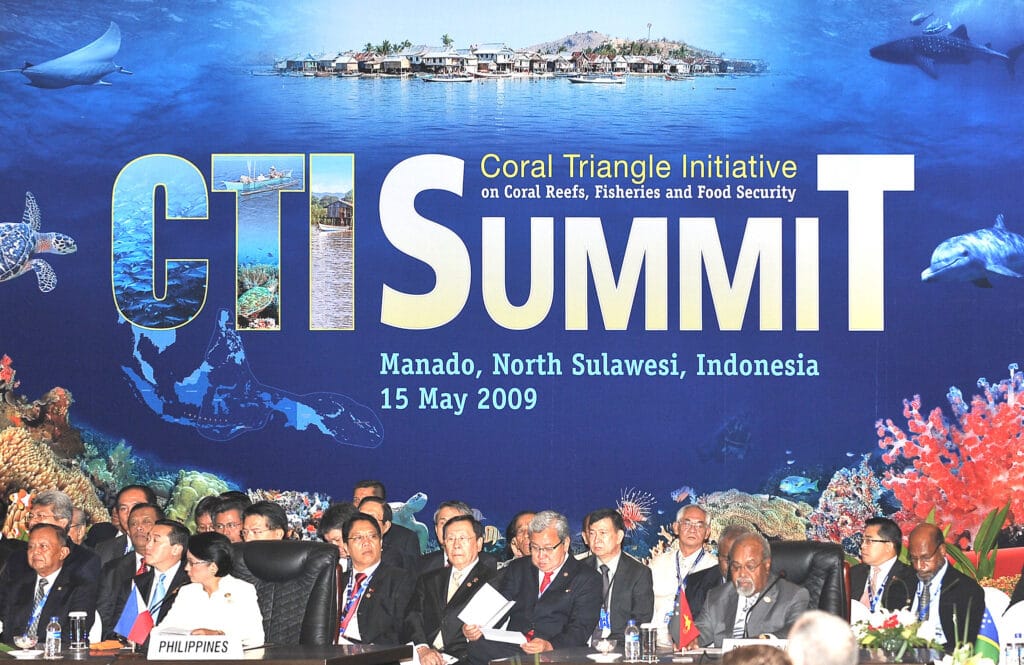
In May 2009, leaders of the six countries that make up the Coral Triangle—Indonesia, Malaysia, the Philippines, Papua New Guinea, Solomon Islands, and Timor-Leste—came together at the World Ocean Conference in Manado, Indonesia, to sign the Leaders’ Declaration on the Coral Triangle Initiative. This pivotal agreement set the stage for regional cooperation aimed at conserving one of the world’s most biodiverse marine ecosystems, which is often referred to as the “Amazon of the seas.”
The declaration was not only a recognition of the area’s global ecological importance but also a promise to ensure its long-term sustainability. But what exactly was outlined in the declaration, what has been accomplished since then, and how has the Philippines, including its regions like Palawan, been involved in these efforts?
Table of Contents
The Importance of the Coral Triangle
The Coral Triangle is a region in the western Pacific Ocean that encompasses six countries and is home to some of the most diverse and productive marine ecosystems in the world. It is often described as the center of marine biodiversity, containing over 76% of all known coral species, 37% of the world’s coral reef fish species, and numerous endangered species, such as the green sea turtle and the dugong. The Coral Triangle is also an economic lifeline for millions of people who depend on its resources for their livelihoods, including fishing and tourism.
The region is facing significant threats, including overfishing, destructive fishing practices, coastal development, pollution, and the impacts of climate change. Rising sea temperatures and ocean acidification are damaging coral reefs, which are vital habitats for countless marine species.
In response to these challenges, the Coral Triangle Initiative (CTI) was launched to foster regional cooperation in addressing these issues and ensuring the long-term protection of the area’s marine resources.
The Goals of the Coral Triangle Initiative
The Leaders’ Declaration on the Coral Triangle Initiative laid out a comprehensive framework for cooperative action, focusing on five key areas:
- Sustainable Fisheries Management: One of the main objectives was to reduce overfishing and promote sustainable fisheries practices that ensure the long-term health of fish stocks and the livelihoods of coastal communities. This includes addressing illegal fishing practices, overfishing, and the introduction of fishing techniques that are environmentally destructive.
- Marine Protected Areas (MPAs): Expanding and strengthening MPAs was a critical goal. These areas are vital for protecting marine biodiversity, restoring fish stocks, and preserving fragile ecosystems like coral reefs. MPAs provide safe zones where marine species can thrive, contributing to the recovery of fish populations and ecosystem health.
- Climate Change Adaptation: The CTI also focused on developing strategies to help the region adapt to the impacts of climate change. As the Coral Triangle is highly vulnerable to rising sea levels, extreme weather events, and ocean acidification, countries in the region committed to implementing measures to enhance the resilience of both marine ecosystems and coastal communities.
- Integrated Coastal Management: Recognizing the interconnectedness of land and sea, the declaration called for integrated coastal management practices that combine land-based and marine-based conservation efforts. This approach helps reduce pollution, protect critical habitats like mangroves and seagrasses, and ensure that development projects do not harm the environment.
- Community Engagement and Livelihood Support: The declaration emphasized the importance of engaging local communities in conservation efforts. This includes supporting sustainable livelihoods and eco-friendly tourism practices that allow communities to benefit economically from protecting their marine resources.
Actions Taken and Progress Made
Since the signing of the declaration, significant progress has been made in implementing the goals of the Coral Triangle Initiative, although challenges persist. Below, we explore the key achievements and ongoing efforts in the region.
1. Marine Protected Areas
One of the major successes of the Coral Triangle Initiative has been the establishment and expansion of marine protected areas (MPAs). These MPAs help conserve coral reefs, seagrass beds, and other vital marine habitats, providing refuges for marine life and supporting the recovery of fish populations.
In the Philippines, which is home to some of the world’s most pristine and ecologically significant marine environments, significant strides have been made in expanding MPAs. The Tubbataha Reefs Natural Park in Palawan is a prime example of a successful MPA that has benefited from the Coral Triangle Initiative. Tubbataha, a UNESCO World Heritage Site, is one of the most biodiverse marine ecosystems in the world, with over 600 species of fish and 360 species of coral.
The protection of this park has been a model of marine conservation, with the Philippine government, local communities, and international organizations working together to safeguard this critical area. The success of Tubbataha has inspired the establishment of other protected areas in the country.
2. Sustainable Fisheries Management
The Philippines has been working to implement sustainable fisheries management practices to reduce overfishing and protect fish stocks. The country’s efforts to address illegal, unreported, and unregulated (IUU) fishing have been critical in maintaining the health of marine ecosystems.
In Palawan, where fisheries play a vital role in local economies, there have been concerted efforts to engage local communities in sustainable fishing practices. Community-based initiatives, such as the establishment of no-take zones and the promotion of sustainable aquaculture, have helped reduce fishing pressure on marine resources. Additionally, local governments and NGOs have worked together to enforce fishing regulations and protect important habitats like coral reefs, mangroves, and seagrass beds.
Despite these efforts, challenges remain in addressing illegal fishing and overfishing, especially in remote areas where enforcement is difficult. However, there has been a growing recognition of the need for stronger governance, better monitoring, and increased collaboration between communities, government agencies, and the private sector to combat these issues.
3. Climate Change Adaptation
The Coral Triangle countries have made efforts to develop strategies for climate change adaptation, which are crucial for preserving marine ecosystems and the livelihoods of coastal communities. The Philippines, as a country highly vulnerable to the impacts of climate change, has been at the forefront of these efforts.
In Palawan, projects aimed at building the resilience of coral reefs, mangroves, and coastal communities have been implemented. These include coral restoration projects, mangrove rehabilitation, and the development of climate-resilient fishing practices. The government and NGOs have worked together to develop climate adaptation plans that help local communities cope with rising sea levels, ocean acidification, and extreme weather events.
Despite these efforts, the impacts of climate change continue to be a significant threat to the region. Coral bleaching events, which are exacerbated by rising sea temperatures, have become more frequent, putting immense pressure on coral reefs and marine life. The long-term success of climate change adaptation strategies will depend on continued regional cooperation and increased investment in climate-resilient infrastructure.
4. Community Engagement
One of the most successful aspects of the Coral Triangle Initiative has been the emphasis on community engagement. Local communities have been integral to the success of marine conservation efforts, as they are often the ones most directly impacted by the degradation of marine resources.
In Palawan, community-based marine conservation projects have gained momentum. These projects have focused on empowering local communities to take part in protecting their natural resources. Programs such as community-managed MPAs, sustainable tourism practices, and coral reef restoration have helped raise awareness about the importance of marine conservation.
Local businesses, including dive shops and tour operators, have increasingly adopted eco-friendly practices, contributing to the protection of the environment while also benefiting economically from sustainable tourism.
The Role of the Philippines and Palawan in the Coral Triangle Initiative
Palawan, often referred to as the “last frontier” of the Philippines, has become a focal point for conservation efforts in the Coral Triangle. The island’s exceptional biodiversity and pristine marine environments make it a critical area for the success of the Coral Triangle Initiative. With world-renowned dive sites like El Nido, Coron, and Tubbataha, Palawan is a hub for marine conservation and eco-tourism in the Philippines.
Tubbataha Reefs stands out as a model of marine protection and has benefited significantly from the Coral Triangle Initiative. As a UNESCO World Heritage Site, Tubbataha receives international attention and resources to ensure its long-term protection. The efforts to safeguard Tubbataha have helped maintain its status as one of the world’s most pristine marine ecosystems.
Additionally, Palawan has become a leader in sustainable eco-tourism. The region’s dive operators, resorts, and local governments have embraced environmentally friendly practices, ensuring that tourism contributes to the conservation of the island’s natural resources. By promoting sustainable diving and snorkeling, Palawan has become a beacon for eco-conscious travelers, raising awareness about the importance of preserving the Coral Triangle’s biodiversity.
A Look at the Results: Where Do We Stand Today?
As of today, the Coral Triangle Initiative has achieved notable successes, but challenges remain. The establishment of MPAs, improvements in fisheries management, and the promotion of climate adaptation strategies have all contributed to the conservation of the region’s marine biodiversity. Palawan, in particular, has been a leader in these efforts, with initiatives like Tubbataha Reefs serving as an inspiration for other protected areas in the Philippines.
However, despite these achievements, the region still faces significant challenges. Illegal fishing, pollution, and climate change continue to threaten the health of coral reefs and marine life. The Philippines, as a key player in the Coral Triangle Initiative, will need to continue working with its neighbors and the international community to address these challenges and ensure the long-term sustainability of the region’s marine ecosystems.
Conclusion
The commitment of the Coral Triangle countries to protect and sustain this valuable marine ecosystem is a crucial step in ensuring the preservation of global biodiversity. Since the signing of the Leaders Declaration at the World Ocean Conference in 2009, efforts have been diverse, ranging from the creation of protected areas to the implementation of stricter conservation policies. The active participation of the Philippines, particularly in regions like Palawan, has been pivotal in making significant progress, highlighted by initiatives like the protection of the Tubbataha Reefs Natural Park, a UNESCO World Heritage Site.
While important strides have been made, the fight for the conservation of the Coral Triangle remains a challenge, given the pressures of human activity, such as unsustainable fishing practices and mass tourism. As governments continue to strengthen their policies and collaborate with international organizations, the long-term sustainability of this ecosystem will also depend on education, local engagement, and the active participation of communities.
The Coral Triangle is more than just a geographical region; it is a treasure trove of biodiversity that offers countless benefits to both current and future generations. Therefore, the joint efforts of the involved countries, conservation organizations, researchers, and tourists will be key to ensuring its preservation. As initiatives continue to evolve, it is imperative that everyone, from leaders to local travelers, plays a role in protecting this invaluable natural heritage.
